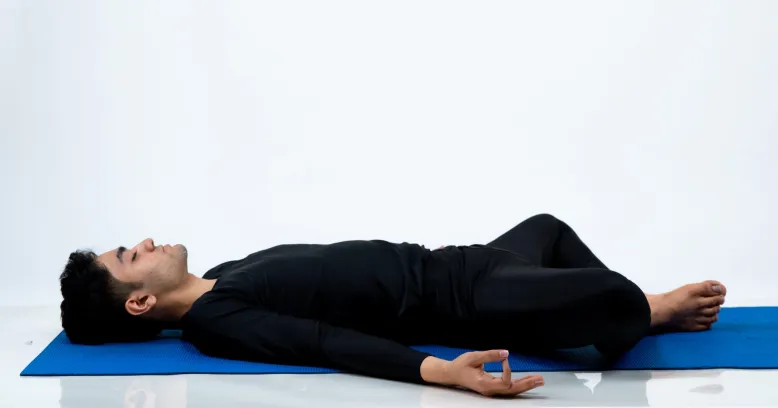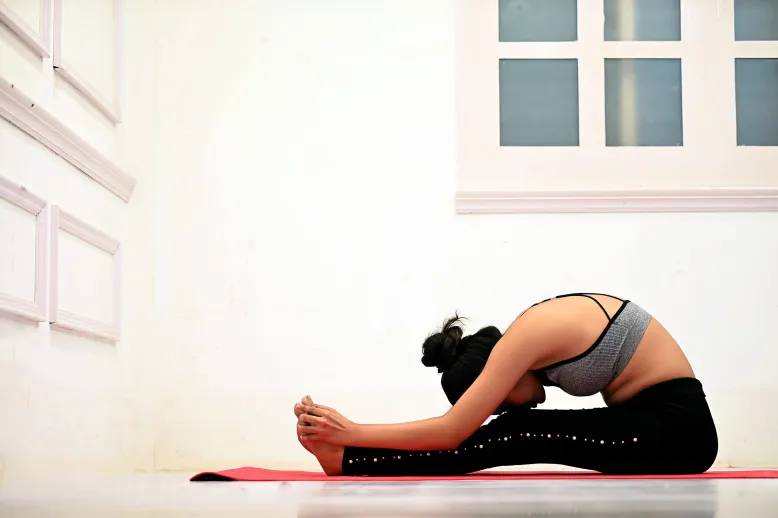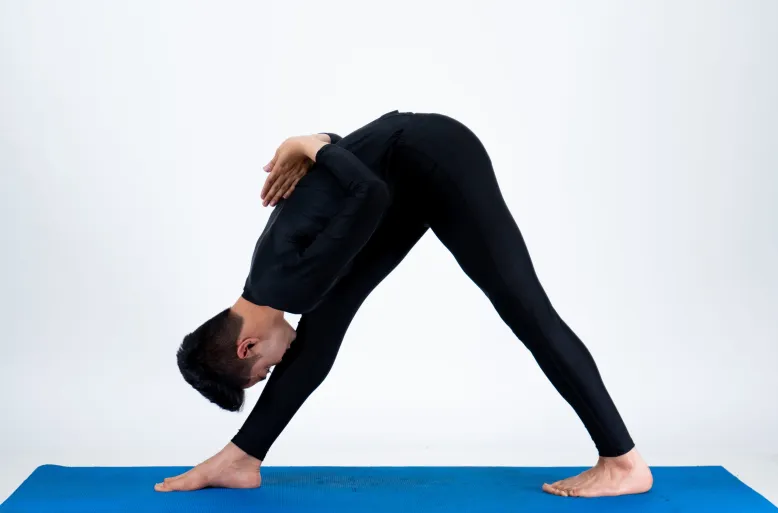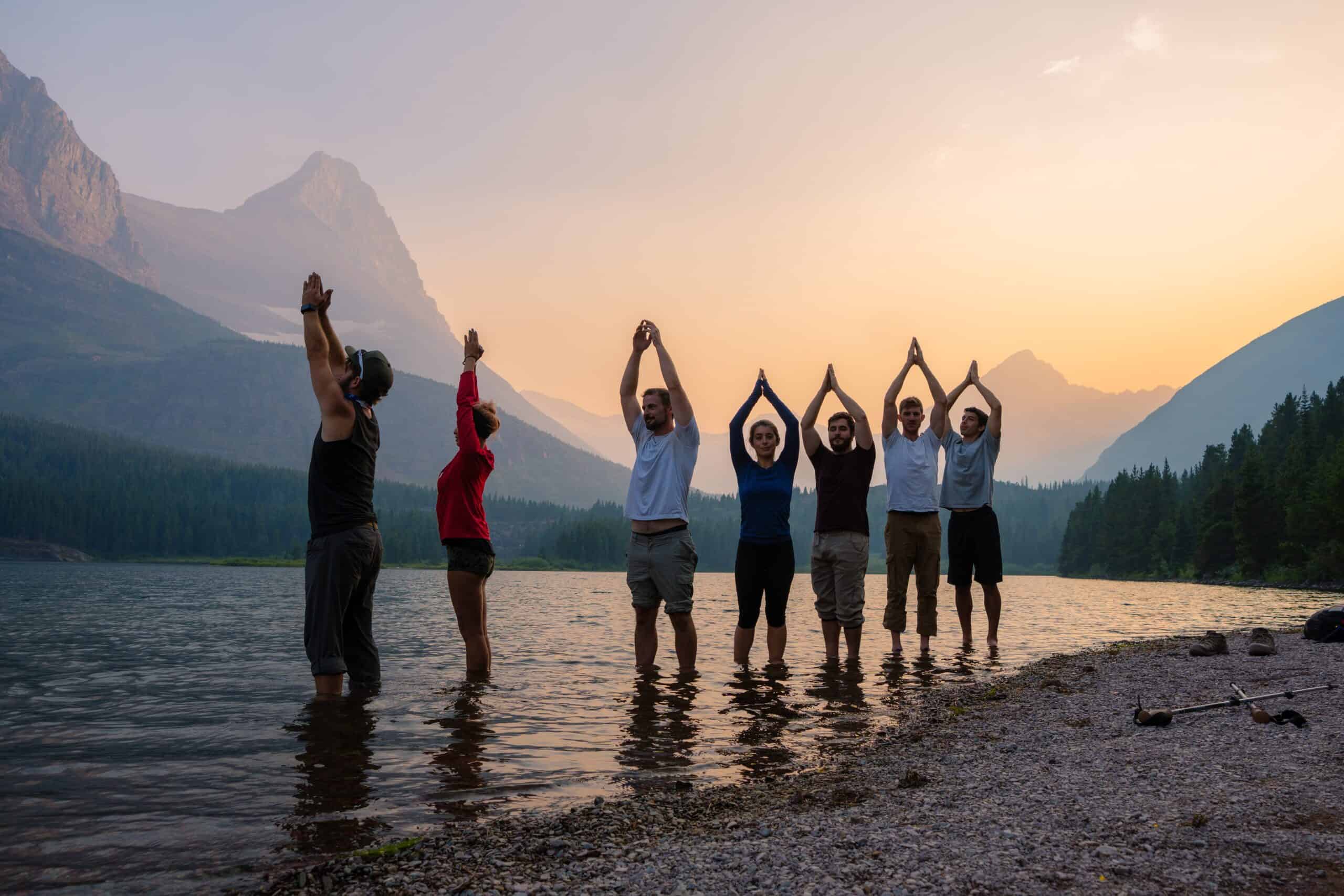Supta Baddha Konasana, commonly known as Reclining Bound Angle Pose, is a wonderfully soothing yoga posture suitable for students of all levels.
It is a version of Baddha Konasana (Bound Angle Pose) that includes reclining on the back. This position opens the hips, inner thighs, and groins while also relieving tension and anxiety.
Origins and Symbolism
Supta Baddha Konasana has its roots in Hatha Yoga, a classical type of yoga that focuses on physical postures (asanas) and breathing practices (pranayama) to achieve balance and harmony in the body and mind. The term alone conveys the essence of the stance.
Supta: Reclining
Baddha: Bound
Konasana: Angle Pose
The asana combines two fundamental poses: Supta Virasana (Reclining Hero Pose) and Baddha Konasana (Bound Angle Pose). Its symbolic importance stems from the union of opposites – the dynamic and the receptive, the masculine and the feminine, the sun and the moon – which represent the harmony of polarities inside oneself.
Benefits of Supta Baddha Konasana:
Regular practice of Supta Baddha Konasana has several advantages for the body, mind, and soul.
- This asana softly opens the hips and groin area, releasing tension and encouraging flexibility and mobility.
- The moderate pressing on the lower belly stimulates the digestive organs, which aids digestion and alleviates digestive disorders.
- Supta Baddha Konasana creates a profound state of relaxation, which calms the nervous system and reduces tension and anxiety.
- Improves Circulation: The reclining posture, when paired with deep breathing, increases blood circulation throughout the body, boosting cardiovascular health and cell rejuvenation.
- Balances the Reproductive System: This position is especially useful for women since it regulates menstrual cycles, relieves menstrual pain, and boosts fertility.
- Promotes Emotional Liberate: The gentle opening of the hips is said to liberate buried emotions and trauma, giving practitioners a cathartic experience.
- Cultivates awareness: Practicing Supta Baddha Konasana promotes awareness and introspection, helping practitioners to connect with themselves on a deeper level.
Physical Alignment and Practice
To perform the Supta Baddha Konasana:
- Begin by sitting on the floor, legs outstretched.
- Bend your knees and bring the soles of your feet together, allowing your knees to fall to the sides.
- Gently recline your torso back onto the floor, using your hands for support.
- Allow your arms to rest comfortably at your sides, palms facing up.
- Close your eyes and concentrate on the natural rhythm of your breathing.
- Hold the stance for 1 to 5 minutes, gradually increasing the time as you gain comfort.
- Maintaining good alignment is essential in Supta Baddha Konasana. Maintain your spine’s length and avoid strain or tension in the neck or shoulders.
- Place blankets or bolsters under your back or legs to provide additional support and comfort.
Cautions and Contraindications
While Supta Baddha Konasana has various advantages, it may not be appropriate for everyone. Individuals with the following conditions should approach the posture cautiously or avoid it entirely:
- Recent Hip or Knee Injuries
- Sacroiliac Joint Dysfunction
- Inner thigh or groin injuries
- Pregnancy (particularly in the late stages)
- Before attempting this position, contact a trained yoga instructor or healthcare expert, especially if you have any pre-existing medical ailments or concerns.
Conclusion:
In the spiritual path of yoga, Supta Baddha Konasana shines as a light of harmony and integration, allowing practitioners to explore the depths of their being with grace and compassion.
As we yield to the soft embrace of this position, we become aware of the vast connectivity of body, mind, and spirit, revealing our boundless potential.
Supta Baddha Konasana is a guiding light, illuminating the route to comprehensive well-being and self-discovery, whether it’s finding peace in times of upheaval or discovering unexpected strength in situations of weakness. Accept the practice with an open heart and a willing mind, and let the transforming path unfold one breath at a time.
What is Supta Baddha Konasana good for?
Supta Baddha Konasana: A Powerful Yoga Pose
• Opens the Hips and Groin: Gently stretch the inner thighs, groins, and hips, releasing tension and tightness.
• Relieves Lower Back Discomfort: Helps alleviate discomfort and stiffness in the lumbar spine.
• Stimulates Abdominal Organs: Promotes digestion, alleviates bloating, and promotes overall abdominal health.
• Calms the Nervous System: Promotes deep relaxation and activates the parasympathetic nervous system, reducing stress and anxiety.
• Improves Circulation: Enhances blood circulation throughout the body, promoting cardiovascular health and vitality.
• Balances the Reproductive System: Regulates menstrual cycles, alleviates discomfort, and improves fertility.
• Promotes Emotional Release: Releases stored emotions and tension held in the pelvic region.
• Cultivates Mindfulness and Inner Awareness: Encourages practitioners to connect with their breath and body in the present moment.
What is the spiritual meaning of Supta Baddha Konasana?
Supta Baddha Konasana, also known as Reclining Bound Angle Pose or Goddess Pose, is a yoga pose that promotes spiritual growth by bringing together opposing energies. It mirrors the sacred geometry found in nature and the universe, symbolizing purity and enlightenment. The pose also encourages the awakening of Shakti, the divine feminine energy in Hindu mythology, by embracing the lotus flower shape. The pose also facilitates the heart opening and surrender, encouraging vulnerability, forgiveness, and unconditional acceptance. The pose also encourages an inner journey of self-discovery, allowing practitioners to explore the subconscious mind and gain clarity on their spiritual path. The spiritual meaning of Supta Baddha Konasana transcends the physical realm, offering a sacred space for practitioners to connect with their higher selves and experience the unity of body, mind, and spirit.
Can I sleep in Supta Baddha Konasana?
Supta Baddha Konasana, or Reclining Bound Angle Pose, is a restorative yoga pose but not suitable for extended sleep due to its limited support, restricted blood flow, and insufficient breathing and airflow. It can cause discomfort and strain on the back, hips, and other body parts. To improve sleep quality, it’s recommended to use the pose as part of a restorative yoga practice or relaxation routine, such as holding the pose for a few minutes before transitioning to a more suitable sleeping position. Integrating relaxation techniques into bedtime routines is also recommended.





No Comments